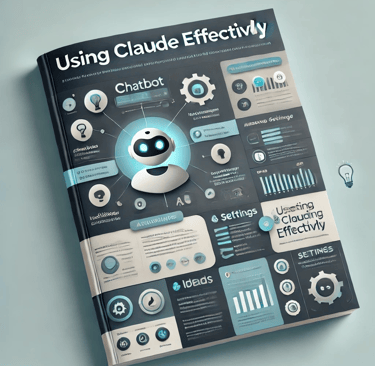Comprehensive Guide to Using Claude Effectively
Claude is an AI assistant created by Anthropic, designed to help with a wide range of tasks including analysis, writing, problem-solving, and creative work. This guide will help you maximize your interactions with Claude, ensuring you get the most accurate, relevant, and helpful responses possible.
#AI#AIAPPLICATIONS#INNOVATIONINAI #TECHINNOVATION#LLMS#CLAUDE
David Kohav
6/27/20246 min read


Comprehensive Guide to Using Claude Effectively
Table of Contents
Introduction
General Tips for Effective Prompting
Task-Specific Tips and Examples
Troubleshooting and Maximizing Performance
Advanced Techniques
Conclusion
1. Introduction
Claude is an AI assistant created by Anthropic, designed to help with a wide range of tasks including analysis, writing, problem-solving, and creative work. This guide will help you maximize your interactions with Claude, ensuring you get the most accurate, relevant, and helpful responses possible.
2. General Tips for Effective Prompting
2.1 Be Clear and Specific
Clearly state your task or question at the beginning of your message.
Provide context and details to help Claude understand your needs.
Break complex tasks into smaller, manageable steps.
Example:
Bad: "Help me with a presentation." Good: "I need help creating a 10-slide presentation for our quarterly sales meeting. The presentation should cover our Q2 sales performance, top-selling products, and sales targets for Q3. Please provide an outline with key points for each slide."
2.2 Use Examples
Provide examples of the kind of output you're looking for.
If you want a specific format or style, show Claude an example.
Example:
Bad: "Write a professional email." Good: "I need to write a professional email to a client about a project delay. Here's a similar email I've sent before: 'Dear [Client], I hope this email finds you well. I wanted to update you on the progress of [Project Name]. Unfortunately, we've encountered an unexpected issue that will delay our completion date by approximately two weeks. We're working diligently to resolve this and will keep you updated on our progress. Please let me know if you have any questions or concerns. Best regards, [Your Name]' Help me draft a new email following a similar tone and structure, but for our current situation where we're delayed by a month due to supply chain issues."
2.3 Encourage Thinking
For complex tasks, ask Claude to "think step-by-step" or "explain your reasoning."
This can lead to more accurate and detailed responses.
Example:
Bad: "How can I improve team productivity?" Good: "I'm looking to improve my team's productivity. Think through this step-by-step, considering the following factors: 1. Current productivity blockers (e.g., too many meetings, unclear priorities) 2. Potential solutions (e.g., time management techniques, project management tools) 3. Implementation challenges 4. Methods to measure improvement For each step, please provide a brief explanation of your reasoning. Then summarize your ideas at the end."
2.4 Iterative Refinement
If Claude's first response isn't quite right, ask for clarifications or modifications.
You can always say "That's close, but can you adjust X to be more like Y?"
Example:
Bad: "Make it better." Good: "That's a good start, but please refine it further. Make the following adjustments: 1. Make the tone more casual and friendly 2. Add a specific example of how our product has helped a customer 3. Shorten the second paragraph to focus more on the benefits rather than the features"
2.5 Leverage Claude's Knowledge
Claude has broad knowledge across many fields. Don't hesitate to ask for explanations or background information.
Be sure to include relevant context and details so that Claude's response is maximally targeted to be helpful.
Example:
Bad: "What is marketing? How do I do it?" Good: "I'm developing a marketing strategy for a new eco-friendly cleaning product line. Can you provide an overview of current trends in green marketing? Please include: 1. Key messaging strategies that resonate with environmentally conscious consumers 2. Effective channels for reaching this audience 3. Examples of successful green marketing campaigns from the past year 4. Potential pitfalls to avoid (e.g., greenwashing accusations) This information will help me shape our marketing approach."
2.6 Use Role-Playing
Ask Claude to adopt a specific role or perspective when responding.
Example:
Bad: "Help me prepare for a negotiation." Good: "You are a fabric supplier for my backpack manufacturing company. I'm preparing for a negotiation with this supplier to reduce prices by 10%. As the supplier, please provide: 1. Three potential objections to our request for a price reduction 2. For each objection, suggest a counterargument from my perspective 3. Two alternative proposals the supplier might offer instead of a straight price cut Then, switch roles and provide advice on how I, as the buyer, can best approach this negotiation to achieve our goal."
3. Task-Specific Tips and Examples
3.1 Content Creation
Specify your audience
Define the tone and style
Define output structure
Example:
"Please help me write a blog post about cybersecurity best practices for small business owners. The audience is not very tech-savvy, so the content should be: 1. Easy to understand, avoiding technical jargon where possible 2. Practical, with actionable tips they can implement quickly 3. Engaging and slightly humorous to keep their interest Please provide an outline for a 1000-word blog post that covers the top 5 cybersecurity practices these business owners should adopt. Use a friendly, conversational tone throughout."
3.2 Document Summary and Q&A
Be specific about what you want
Use the document names
Ask for citations
Example:
"I've attached a 50-page market research report called 'Tech Industry Trends 2023'. Can you provide a 2-paragraph summary focusing on AI and machine learning trends? Then, please answer these questions: 1. What are the top 3 AI applications in business for this year? 2. How is machine learning impacting job roles in the tech industry? 3. What potential risks or challenges does the report mention regarding AI adoption? Please cite specific sections or page numbers when answering these questions."
3.3 Data Analysis and Visualization
Specify the desired formatClearly describe the format you want the data in.
Example:
"I've attached a spreadsheet called 'Sales Data 2023'. Can you analyze this data and present the key findings in the following format: 1. Executive Summary (2-3 sentences) 2. Key Metrics: - Total sales for each quarter - Top-performing product category - Highest growth region 3. Trends: - List 3 notable trends, each with a brief explanation 4. Recommendations: - Provide 3 data-driven recommendations, each with a brief rationale After the analysis, suggest three types of data visualizations that would effectively communicate these findings."
3.4 Brainstorming
Use Claude to generate ideas by asking for a list of possibilities or alternatives.
Request responses in specific formats like bullet points, numbered lists, or tables for easier reading.
Example:
"We need to come up with team-building activities for our remote team of 20 people. Can you help me brainstorm by: 1. Suggesting 10 virtual team-building activities that promote collaboration 2. For each activity, briefly explain how it fosters teamwork 3. Indicate which activities are best for: a) Ice-breakers b) Improving communication c) Problem-solving skills 4. Suggest one low-cost option and one premium option."
4. Troubleshooting and Maximizing Performance
4.1 Allow Claude to Acknowledge Uncertainty
Tell Claude that it should say it doesn't know if it's unsure about something.
Example: "If you're unsure about something, it's okay to admit it. Just say you don't know."
4.2 Break Down Complex Tasks
If a task seems too large and Claude is missing steps or not performing certain steps well, break it into smaller steps and work through them with Claude one message at a time.
4.3 Include All Contextual Information for New Requests
Claude doesn't retain information from previous conversations, so include all necessary context in each new conversation.
5. Advanced Techniques
5.1 Multi-Step Problem Solving
For complex problems, guide Claude through a step-by-step process:
Define the problem clearly
Break down the problem into smaller components
Ask Claude to address each component separately
Synthesize the results
Example:
"Let's solve a complex business problem step-by-step. Our e-commerce startup is experiencing a high cart abandonment rate. Step 1: Analyze potential causes Please list 5 common reasons for high cart abandonment rates in e-commerce. Step 2: Data gathering What data points should we collect to identify which of these reasons apply to our situation? Step 3: Solution brainstorming For each potential cause, suggest 2-3 possible solutions. Step 4: Implementation plan Choose the top 3 solutions and outline a basic implementation plan for each. After we complete these steps, we'll review the results and decide on next actions."
5.2 Comparative Analysis
Ask Claude to compare and contrast different options or viewpoints:
Example:
"I'm considering three different project management methodologies for our software development team: Agile, Waterfall, and Kanban. Can you provide a comparative analysis of these three approaches? Please include: 1. A brief description of each methodology 2. The key principles underlying each approach 3. Pros and cons of each methodology 4. Best use cases for each 5. Potential challenges in implementing each methodology Present this information in a table format for easy comparison. After the table, please provide a recommendation on which methodology might be best for a small, fast-paced startup, and explain your reasoning."
5.3 Scenario Planning
Use Claude to help with scenario planning and decision-making:
Example:
"Our company is considering expanding into the Asian market. Can you help me with some scenario planning? Please consider three possible scenarios: 1. Best case: Rapid adoption and growth 2. Most likely case: Moderate growth with some challenges 3. Worst case: Significant barriers and slow adoption For each scenario, please provide: a) A brief description of the scenario b) Key factors that would lead to this scenario c) Potential outcomes (both positive and negative) d) Recommended strategies to maximize opportunities or mitigate risks After outlining these scenarios, please suggest 3-5 key indicators we should monitor to help us identify which scenario is unfolding as we enter the market."
6. Conclusion
Effective use of Claude involves clear communication, specific instructions, and an understanding of Claude's capabilities. By following the tips and techniques in this guide, you can maximize the value of your interactions with Claude, whether you're working on simple tasks or complex projects.
Remember that Claude is a tool to augment your own thinking and decision-making. While it can provide valuable insights and assistance, it's important to apply your own judgment and expertise to the information and suggestions it provides.
Happy collaborating with MLDK(https://mldk.tech)!
